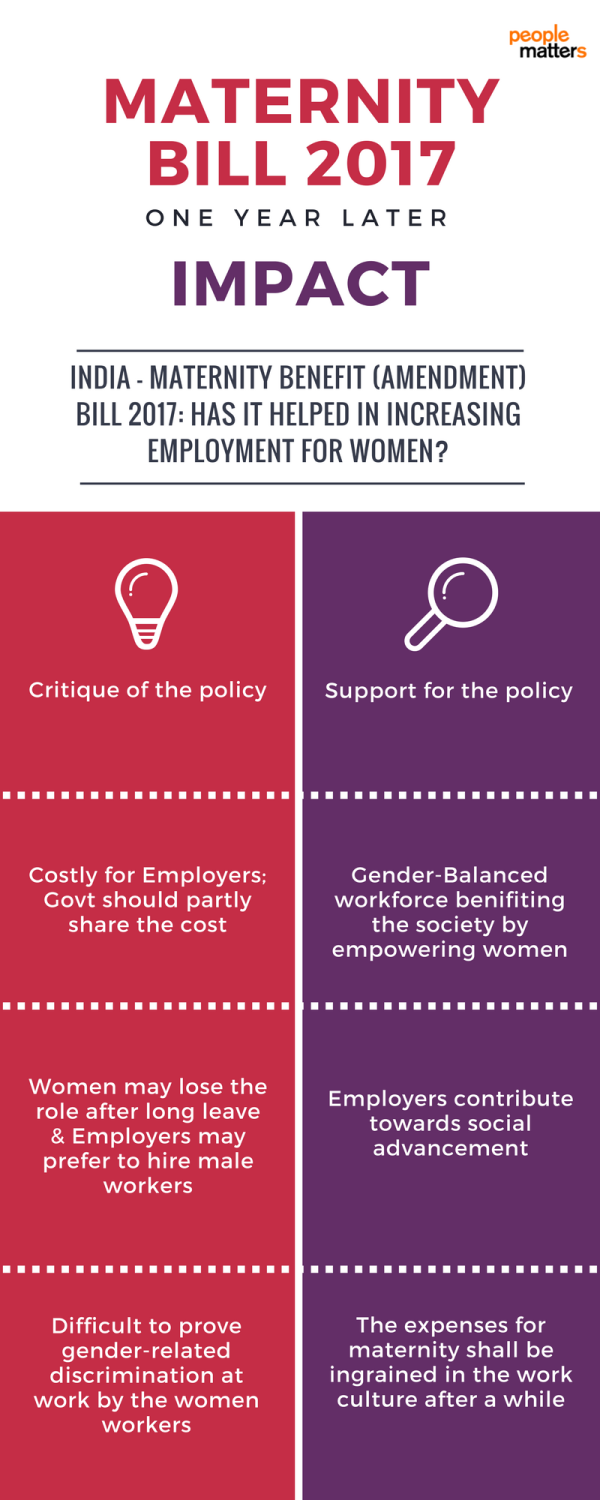Maternity bill 2017– Has it helped in increasing employment for women?

The Maternity Benefit (Amendment) Bill, 2017 was a landmark decision. However, few weeks before its 1st anniversary, we asked our community: Has it helped in increasing the number of employed women?
The responses were mixed.
The Bill increased the duration of paid maternity leave from 12 weeks (with not more than 6 weeks preceding the expected date of delivery) to 26 weeks (with not more than 8 weeks preceding the expected date of delivery); introduced paid adoption leave (if the adopted child is less than three months old) and paid surrogacy leave of 12 weeks from the date when the child is handed over; and also made mandatory for each establishment with 50 or more employees to have a crèche facility.
We asked our community across People Matters social platforms and gathered inputs from HR Leaders. What is the effect they have observed? Has it increased employment for women? Across many comments we received, many welcomed the decision, while there were some who thought the demands from employers were excessive too, considering the financial implications.
Critique of the policy
HR leaders showed positive support as well as apprehensions in implementing this policy. Here are some of the concerns raised by the community.
“Not sure; has made hiring women more expensive”
- Many women are at low salary levels. Hence, many employers may see them as dispensable and women, in general, may face discrimination at the hiring stage.
- Newlywed women employees may find it more difficult to get hired.
Employers may see maternity benefits as extra expenses for the organizations. Especially, the businesses that are running on small budgets and are fluid in the nature of their work resent this extra expense.“Six months’ maternity leave has impacted newlywed women employment. I think we should fix the loopholes and have a practical approach in implementing it," said Rati Diwan Associate Vice President-HR, Max Bupa Health Insurance
“Cost for employers have gone up”
While many companies took the lead and implemented revised (longer) maternity policy even before the Act came into effect, the reality is that employers are bearing this additional cost by themselves. In most countries with extensive childcare benefits, the government shares some part of the financial costs. Singapore has 16 weeks of paid leave, 8 are funded through public funds. In Australia and Canada, the respective maternity leave of (18) and (17) weeks is paid by public funds. In India however, except for the fraction of employees covered under the Employee State Insurance Act (ESI Act) (i.e. employees earning not more than INR 21,000 per month), maternity benefits have to be financed by the employer.
Support for the policy
Some respondents supported the policy and highlighted the intangible benefits of having a gender-balanced workforce. Their responses follow.
“Yes, it has helped– a small start BUT a well-received one”
It got India among the 16 countries having the longest paid leave for new mothers, with the intent to create a more supportive policy for all working mothers in employment.
The HR leaders, who support the policy, welcome the increasing gender-balanced workforce that this law shall bring. They feel that the costs incurred on the companies are not too much when we compare them with the intangible benefits that this law has the potential to bring. They also feel that with time, companies shall accept it as a normal policy to spend on maternity benefits.
“These extended benefits have provided immense support to a woman at a crucial stage in her life and by doing so, has allowed her to return to work a little more easily than in the past. These additional costs have zero influence on our decision to hire women. The intangible benefits of having a gender-balanced workforce outweigh the costs many times over,” Hari T.N, HR- Head, BigBasket
Some HR leaders have highlighted the health benefits of the mother and child because of this law and have exhorted upon the companies to accept this policy as a natural outcome of the vision to promote a healthy society. They also reflect upon the gender diversity of the workforce that this policy is likely to bring about.
What is needed next?
Three recommendations emerged from the community for the Maternity Bill 2017 to have a deeper impact on job-creating for women:
- Small businesses should get financial assistance from the government to implement maternity benefits
- Reinforcing the law about not terminating women during or after maternity is critical
- Organizations should adopt a long-term view on diversity & inclusion as the business benefits will not emerge short term
“A great step by the Government, but they can only give the guardrails. Organizations have to up their agenda beyond virtue signaling! Compensation budgets and manpower planning don't consider that part of the workforce constitutes of women and one would need to include this in the planning. We plan for campus hires, GET but no integrated thought process for inclusiveness; it's very patchy. I wish there are some inspiring corporate examples to make this a reality and not just talk about boardroom ratios,” said Shelly Singh, Co-founder, PeopleStrong
The overall sentiment from leaders is that the businesses should go beyond talking about the numbers in the boardrooms and should implement work practices and policies that help the women workers at all rungs of the workforce.

Please share your experience & continue the conversation! We will love to hear your point of view on how Maternity Benefit (Amendment) Bill 2017 has helped your organizations, industry, sector, bringing more women to work.











